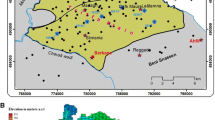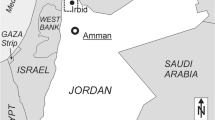Abstract
A large-scale numerical flow and transport model was developed for the central-eastern arid part of the Arabian Peninsula. The model was applied to a region with freshwater resources dating back to more humid periods of the past, which are faced with overexploitation today. Model inflow was based on infiltration around wadi beds and groundwater recharge. Inflow was balanced by natural outflows, such as evaporation from sabkhas, spring discharge, and discharge to the sea. Two models were developed: (1) a short-term present-day model to estimate effective model parameters, and (2) a long-term model to study the development of the groundwater resources during the Mid- and Late Holocene and the natural response of the groundwater system to changes in climate. Hydraulic model parameters (hydraulic conductivity and specific storage) were assigned with respect to geological structures. Hydraulic parameters were estimated with an inverse PEST model by calibrating against observed depression cones cause by groundwater abstraction. Sensitivity analysis demonstrated that estimated model parameters were associated with a high uncertainty at a certain distance from agricultural areas when calibration data were lacking. A long-term model starting 10,000 years BP was calibrated by spring discharge and palaeo-groundwater levels and validated using measured 14C groundwater ages. The long-model predicted that groundwater levels adapted in response to changes in precipitation. During the Mid-Holocene, which was characterized by an intensification of the monsoon season, groundwater levels increased by 10 m on the mainland within the shallow aquifers and adapted quickly to higher recharge rates. The deeper aquifers were less affected by changes in climate. Along the present-day coastline, the groundwater level rose by about 25 m due to the declined sea level in the Mid-Holocene. During this period, surface run-off was possible as groundwater levels temporarily reached the ground surface. The natural groundwater budget reacted sensitively to changes in climate. Between 10 and 3 ka, groundwater storage occurred. During the Late Holocene, at 3 ka, natural depletion of the groundwater system began, which still prevails today.









Similar content being viewed by others
References
Al-Sayari SS, Zötl JG (1978) Quaternary period in Saudi Arabia. A cooperative research project of the University of Petroleum and Minerals, Dhahran and the Austrian Academy of Sciences. Springer, New York
Anderson MP, Woessner WW (2002) Applied groundwater modeling. Simulation of flow and advective transport. Elsevier, San Diego
Bahroudi A (2003) The effect of mechanical characteristics of basal decollement and basement structures on deformation of the Zagros Basin. Ph.D. thesis at the Faculty of Science and Technology. Uppsala, Sweden
Bakiewicz W, Milne DM, Noori M (1982) Hydrogeology of the Umm Er Radhuma aquifer, Saudi Arabia with Reference to Fossil Gradients. Q J Eng Geol 15:105–126
Beineke J (2006) Spät-quartäre Paläographie der Arabischen Halbinsel. Ph.D. Thesis at the University of Paderborn, Germany (in German)
Braconnot P, Otto-Bliesner B, Harrison S, Jaussaume S, Peterchmitt J-Y, Abe-Ouvhi A, Crucifix M et al (2007) Results of PMIP2 coupled simulations of the Mid-Holocene and Last glacial Maximum- Part 1: experiments and large scale features. Clim Past 3:261–277
Braconnot P, Marzin C, Gregoire L, Mosquet E, Marti O (2008) Monsoon response to changes in Earth’s orbital parameters: comparison between simulations of the Eemian and of the Holocene. Clim Past 4:281–294
Brice WC (1978) The environmental history of the near and middle east since the last ice age. Academic Press, London
Bureau de Recherches Geologique et Minieres (BRGM) (1977) Al Hassa Development Project: groundwater resources study and management program. Report for the Ministry of Agriculture and Water of Saudi Arabia, Riyadh (unpubl.)
Christensen JH, Hewitson B, Busuioc A, Chen A, Gao X, Held I, Jones R, Kolli RK, Kwon W-T, Laprise R, Magaña Rueda V, Mearns L, Menéndez CG, Räisänen J, Rinke A, Sarr A, Whetton P (2007) Regional climate projections. In: Solomon S, Qin D, Manning M, Chen Z, Marquis M, Averyt KB, Tignor M, Miller HL (eds) Climate change 2007: the physical science basis. Contribution of Working Group I to the Fourth Assessment Report of the Intergovernmental Panel on Climate Change. Cambridge University Press, Cambridge, United Kingdom and New York, USA
Cohen D, Person M, Wang P, Gable CW, Hutchinson D, Marksamer A, Dugan B, Kooi H, Groen K, Lizarralde D, Evans RL, Day-Lewis FD, Lane JW (2010) Origin and extent of fresh paleowaters on the atlantic continental shelf, USA. Groundwater 48(1):143–158
Doherty J (2010) PEST—Model-independent parameter estimation. User’s Manual, 5th edn. Watermark Numerical Computing, Brisbane
Doherty J, Johnston JM (2003) Methodologies for calibration and predictive analysis of a watershed model. J Am Water Resour As 39(2):251–265
Edgell HS (2006) Arabian deserts. Nature, origin and evolution. Springer, Dordrecht
Engelhardt I, Prömmel K (2012) Impact of long-term changes in climate on groundwater resources in an Arid Setting. IAHS Red Book, vol 355. IAHS Publication, pp 298–305
Engelhardt I, Rausch R, Keim B, Al-Saud M, Schüth C (2013) Surface and subsurface conceptual model of an arid environment with respect to Holocene climate changes. Environ Earth Sci 69 (2) (this issue). doi:10.1007/s12665-013-2303-5
Fleitmann D, Burns SJ, Mudelsee M, Neff U, Kramers J, Mangini A, Matter A (2003) Holocene forcing of the Indian Monsoon recorded in a stalagmite from Southern Oman. Science 300:1737–1739
Goode DJ (1996) Direct simulation of groundwater age. Water Resour Res 32(2):289–296
Green R, Bertetti F, Hernandez M (2012) Recharge variability in semi-arid climates. Nat Educ Knowl 3(3):10
Groundwater Development Consultants (GDC) (1980) Umm Er Radhuma Study. Report for the Ministry of Agriculture and Water of Saudi Arabia, Riyadh (unpubl.)
Harbaugh AW, Banta ER, Hill MC, McDonald MG (2000) MODFLOW-2000, the U.S. Geological Survey Modular Groundwater Model User Guide to Modularization Concepts and the Groundwater Flow Process. U.S. Geological Survey Open-File Report 00-9. Denver, CO, Reston, VA
Helmig R (1997) Multiphase flow and transport processes in the subsurface. A contribution to the modeling of hydrosystems. Environmental engineering. Springer, Berlin
Hill MC (1992 )A computer program (MODFLOWP) for estimating parameters of a transient, three-dimensional groundwater flow model using nonlinear regression: USGS OFR 91-484
Hill MC, Tiedeman CR (2007) Effective groundwater model calibration, with analysis of sensitivities, predictions, and uncertainty. Wiley, New York
Hinkelmann R (2005) Efficient numerical methods and information processing techniques for modeling hydro- and environmental systems. Lecture notes in applied and computational mechanics, vol 21. Springer, Berlin
Hötzl H, Zötl JG (1984) Hydrogeology. In: Jado AR, Zötl JG (eds) Quaternary period in Saudi Arabia, vol 2. Springer, Vienna, pp 246–274
Hötzl H, Wohnlich S, Zoetl JG, Benischke R (1993) Verkarstung und Grundwasser im As Summan Plateau (Saudi Arabien). Steir. Z. Hydrogeologie. 44:5–158
Konert G, Afifi AM, Al-Hajri SA, Droste HJ (2001) Paleozoic stratigraphy and hydrocarbon habitat of the Arabian plate. GeoArabia 6:407–442
Larsen CE (1983) Life and land use on the Bahrain Island. The geoarcheology of an Ancient Society. Prehistoric Archeology and Ecology. University of Chicago, Chicago
Lemke PJ, Ren RB, Alley I, Allison I, Carrasco J, Flato G, Fujii Y, Kaser G, Mote P, Thomas RH, Zhang T (2007) Observations: changes in snow, ice and frozen ground. In: Solomon S, Qin D, Manning M, Chen Z, Marquis M, Averyt KB, Tignor M, Miller HL (eds) Climate change 2007: the physical science basis. Contribution of Working Group I to the Fourth Assessment Report of the Intergovernmental Panel on Climate Change. Cambridge University Press, Cambridge, United Kingdom and New York, USA
Levenspiel O (2002) The chemical reactor omnibook. Oregon State University Book Stores, Inc., Corvallis
Margat J (2007) Great aquifer systems of the World. In: Chery L, de Marsily G (eds) Aquifer systems management: Darcy’s Legacy in a World of Impending Water Shortage. Int Assoc Hydrogeol Selected Papers. 10: 105–116
Pritchett JW, Garg SK (1980) Determination of effective well block radii for numerical reservoir simulations. Water Res Res 16(84):665–674
Purser BH (1973) The Persian Gulf. Holocene carbonate sedimentation and diagenesis in a shallow Epicontinental Sea. Springer, Berlin
Rahmstorf S (2007) A semi-empirical approach to projecting future sea-level rise. Science 315(5810):368–370
Sadiq AM, Nasir SJ (2002) Middle pleistocene karst evolution in the state of Qatar, Arabian Gulf. J Cave Karst Stud 64(4):132–139
Scanlon BR, Tyler SW, Wierenga PJ (1997) Hydrologic issues in arid, unsaturated systems and implications for contaminant transport. Rev Geophys 35(4):461–490
Scanlon BR, Keese KE, Flint AL, Flint LE, Gaye CB, Edmunds M, Simmers I (2006) Global synthesis of groundwater recharge in semiarid and arid regions. Hydrol Process 20:3335–3370
Scharffenberg WA, Fleming MJ (2009) Hydrological modeling system HEC-HMS. User’s Manual. Vers. 3.4. Report 0704-0188 U.S. Army Corps of Engineers, Davis
Silberhorn-Hemminger A, Süß M, Helmig R (2005) Natural fractured porous systems. In: Dietrich P, Helmig R, Sauter M, Hötzel H, Köngeter J, Teutsch G (eds) Flow and transport in fractured porous media. ISBN 3-540-23270-2, Springer, Berlin
Sophocleous M (2000) From safe yield to sustainable development of water resources—the Kansas experience. J Hydrol 235:27–43
Süß M, Helmig R (2005) Model concepts in fractured porous systems. In: Dietrich P, Helmig R, Sauter M, Hötzel H, Köngeter J, Teutsch G (eds) Flow and transport in fractured porous media. ISBN 3-540-23270-2, Springer, Berlin
Thornthwaite CW (1948) A new and improved classification of climates. Geogr Rev 38(1):55–94
United Nations Educational, Scientific and Cultural Organization (UNESCO) (2004) Groundwater resources of the World (1:50,000,000). Groundwater Resources of the World-Transboundary Aquifer Systems. WHYMAP, Paris
United Nations Environment Program (UNEP) (2007) Global environment outlook 4. Progress Press Ltd, Malta
Vidal FS (1951) The Oasis of Al-Hassa, Saudi Arabia. ARAMCO, Dhahran
Wagner W, Geyh MA (1999) Application of environmental isotop methods for groundwater studies in the ESCWA region. Geol Jahrbuch Reihe C. 67, Schweizerbart, Hannover
Zheng C (2006) MT3DMS v 5.2 Supplemental User’s Guide, Technical Report to the U.S. Army Engineer Research and Development Center, Department of Geological Sciences, University of Alabama, Tuscaloosa
Acknowledgments
Our investigations benefited notably from scientific discussions with Henning Prommer (CSIRO, Australia). Many thanks go to Martin Kastowski for his support using the Geographic Information System and to the Language Services of Forschungszentrum Jülich (Germany), where a native-English speaker carefully checked the language and grammar of the manuscript.
Author information
Authors and Affiliations
Corresponding author
Rights and permissions
About this article
Cite this article
Engelhardt, I., Rausch, R., Lang, U. et al. Impact of Preboreal to Subatlantic shifts in climate on groundwater resources on the Arabian Peninsula. Environ Earth Sci 69, 557–570 (2013). https://doi.org/10.1007/s12665-013-2362-7
Received:
Accepted:
Published:
Issue Date:
DOI: https://doi.org/10.1007/s12665-013-2362-7




